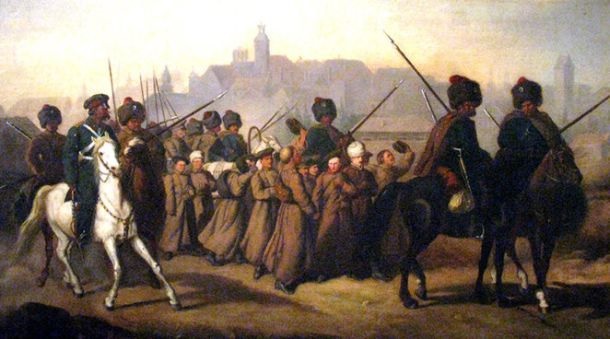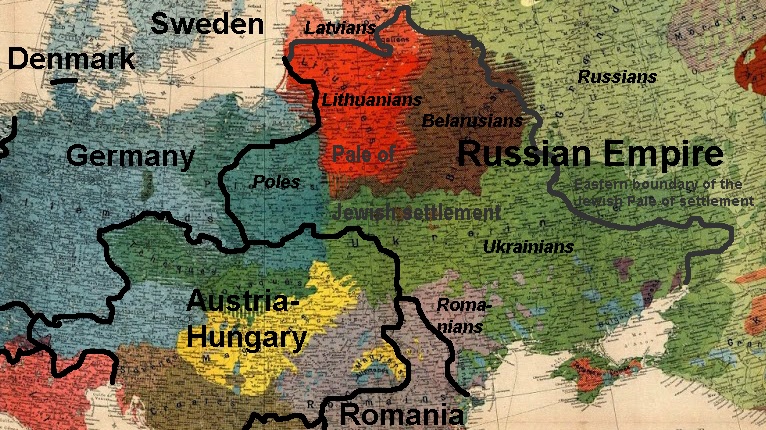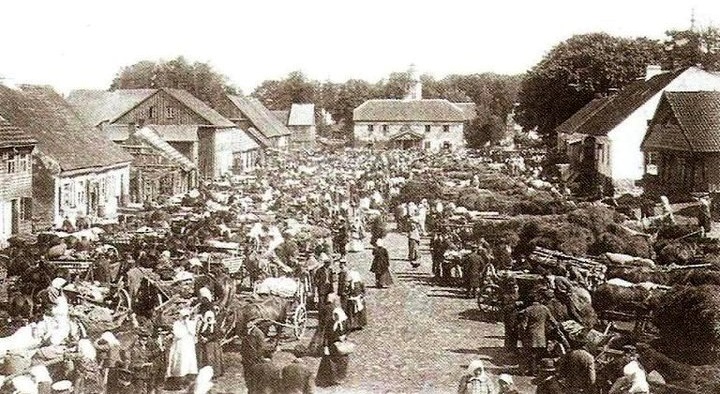Ethnic relations in Lithuania during Russian Empire (1795-1918)
To many people of Lithuania, the 1795 Russian Imperial rule started as a mere change of the regime. However, by the mid-19th century, it turned into a major Russification drive, where non-Russian ethnicities were expected to assimilate into the Russian nation. Based on their sizes and relationship with the ruling regime, the ethnic communities of Lithuania found themselves in different situations and developed separate goals under such pressure. Even the centuries-old Polish-Lithuanian unity withered. Ultimately, Lithuania and Poland became independent separate countries in 1918.
Polish-Russian relations (1795-1918). Right from the collapse of the Polish-Lithuanian Commonwealth, Poles resented the Russian rule, organizing two revolts (1831, 1862) that took place in Lithuanian lands as well. The revolts failed, however, and part of the Polish nobility of Lithuania was persecuted for supporting them. Poles were seen by Russians as one of the most dangerous minorities to the unity of the Russian Empire.

Polish-led mutineers against the Russian czar
Lithuanian-Russian relations (1795-1918). The massive Russian discrimination of Lithuanians began in the 1860s (after the second Polish uprising) when the Lithuanian language was outlawed from public use and print. Other policies included the deportation of some Lithuanians to Siberia, settlement of Lithuania by ethnic Russians, mass conversion of Catholic churches to Russian Orthodox use, dispossession of the Lithuanian nobility. These policies named "Restoration of the Russian beginnings" as Russians believed that "before becoming Polonized, Lithuania was ethnically Russian", denying the existence of the Lithuanian nation altogether and seeing Lithuania merely as a pawn in the Russian-Polish struggle for dominance. Lithuanians safeguarded their assaulted culture illegally by "bookcarriers" (who smuggled Lithuanian books from Lithuania Minor) and "daraktoriai" (secret teachers of the Lithuanian language). Such "cultural defense" eventually turned into a massive Lithuanian national revival. After discriminatory measures were finally curbed in 1904, Lithuanians increasingly demanded even more: autonomy and later independence.

As part of the 'restoration of the Russian beginnings', Russians have reconstructed the St. Nicholas Orthodox church from a local Baroque to a more-Russian-looking Neo-Byzanthine style.
Lithuanian-German relations (1795-1918) in the German-ruled part of Lithuania were rather good. However, the area was gradually slowly Germanizing as ethnic Germans moved into its towns while Lithuanians who moved into towns also often would switch to speaking German over generations. As such, the Lithuanian-speaking area of Prussia/Germany halved during the 19th century. That said, there was no state-sponsored persecution of Lithuanians. They were allowed to print Lithuanian language materials both for local use and to smuggle into Russian-ruled Lithuania where they were banned.

'1890s Lithuanian newspapers printed in German-ruled Lithuania minor. The left one is for local use, using more German loanwords and a German fraktur typeset, while the right one is meant for export into Lithuania-proper. This illustrates the mostly peaceful Germanization that went on in Lithuania Minor
Lithuanian-Polish relations (1795-1918). In the early 19th century, Lithuanian and Polish intellectuals shared an idea to recreate Polish-Lithuanian Commonwealth, fighting in two failed uprisings against Russia together (1831, 1862). As the century progressed however and serfdom was abolished, more and more Lithuanians began seeking to establish Lithuania independent of both Russia and Poland. While this included some nobles, the ideas became more widespread among non-nobles who were getting increasingly educated (after all, only 27,7% of nobles spoke Lithuanian in 1897, with 59,4% speaking Polish natively, whereas the peasants were primarily Lithuanian-speakers). Lithuanian-Polish relations thus largely coincided with class relations between landless peasants (Lithuanians) and landed nobility (Poles). It should be noted that "Lithuanian" and "Pole" were largely a cultural choice at the time as most local self-identified Poles would actually be of Lithuanian descent. Later, after it became usual to consider oneself just a Pole or a Lithuanian, there were cases where even siblings would "choose" different ethnicities.

An 1822 book by Adam Mickiewicz (Lithuanian: Adomas Mickevičius), a famous poet who wrote praises for Lithuania in the Polish language. In his days (1798-1855) the term Lithuanian included Polish native speakers of Lithuanian descent. Soon afterward, however, the goals of two nations divulged. ©Augustinas Žemaitis.
Russian-Jewish relations (1795-1918). Russians viewed the Jewish population of the Empire with distrust, but they also used Jews to dilute ethnic majorities in the Empire's Western lands, among them Lithuania. These became the only Imperial areas where Jews could freely settle, so-called "Pale of Settlement" and some towns thus even became Jewish majority. Jews were allowed to control the area's business (85%-95% of Lithuania's businessmen were Jewish in the era), leaving the political sphere to Russians. Even if the Jewish businessmen may have been well-off by Russian standards, Russia as a whole was poor on the global scale. So by the late 19th century, many Jews would opt to emigrate to the USA or Palestine, decreasing their population share in Lithuania.

The map of the Jewish pale of settlement superimposed on the ethnic map of pre-WW1 Europe. As it is clearly visible, the eastern boundary of the Pale of Jewish settlement follows closely the eastern boundary of minority-majority regions of the Russian Empire. The Jewish pale of settlement nearly entirely corresponds to the area of the Russian Empire that was inhabited by Belarusians, Poles, Lithuanians, Ukrainians, and Romanians. The Jewish settlement allowed to make these areas more diverse (making any unified separatism more difficult), whereas Russia's heartland became more ethnically Russian
Lithuanian-Jewish relations (1795-1918). Lithuanians and Jews had very little contact as Lithuanians were nearly all peasants (working land) while Jews nearly all lived in towns (doing business), and neither group had political powers. The only time they would interact was when Lithuanian peasants would visit marketplaces and fairs. While nationalism was on the rise both among Lithuanians and Jews, these ideas did not clash as nationalist Jews (Zionists) generally saw Lithuanian independence as an irrelevant cause and instead wanted to create Israel in Palestine, where many emigrated. To Lithuanians, the Lithuanian independence meant regaining sovereignty from Russians and lands from Polish-speakers, with Jews not considered as enemies (the business sphere where Jews dominated was considered to be of secondary importance to most Lithuanians). This was among reasons why there was little anti-Semitic violence in Lithuania, compared to other lands of the Russian Empire (Poland, Moldova, Ukraine), where the interests of the "local majority" and Jews tended to collide more. Jews were also the most culturally different community an average Lithuanian of that pre-travel era would encounter, giving them a unique place in Lithuanian folklore.

A market day in pre-war Gargždai. Town markets were one of the very few places where Lithuanians (buyers) and Jews (sellers) would have a reason to talk to each other and even there the conversations were limited to the sale.
Lithuanian-Gypsy relations (1795-1918). While there were few Gypsies in Lithuania, they had more contact with Lithuanians than other ethnic minorities. That's because most Lithuanians were peasants, and Gypsies generally traveled among the peasants, trading with them (and sometimes stealing from them). Gypsies thus became ingrained in the Lithuanian folklore nearly as much as Jews (a much larger community). In the 19th-century Lithuanian folklore, Gypsies are often romanticized, described as hot-tempered and good lovers (a stereotypical role filled by Italians, Spanish or French in the 21st-century imagination).
Russian-Gypsy relations (1795-1918). Russians sought to make Gypsies live a sedentary life. However, they failed. It is assumed many Gypsies have left Lithuania altogether, or simply evaded any censae.
Lithuanian-Westerner* relations (1795-1918). After Russia abolished the slavery-like serfdom many Lithuanians had previously endured (1861), Lithuanians became free to leave their "noble owners". Hundreds of thousands chose to leave their homeland altogether, especially for the USA. This was the first massive direct contact between Lithuanians and Westerners. Speaking little English, Lithuanian-Americans remained a separate community, establishing their own massive churches and other institutions. They also rallied foreign support for Lithuanian rights within the Russian Empire as well as Lithuanian independence. On the other hand, as Lithuania was just a province of the Russian Empire, almost no Westerners would come to live there at the time, making the Lithuanian emigrants (and their letters home) the only Lithuanian-Westerner link.

The first wave Lithuanian-Americans campaign for the liberty of Lithuania in the 1910s.
*Westerners (as used in this article) are people of the Western world, except for Germans. The group includes British, French, Spanish, Italian, American, Scandinavian, Dutch, and other Western ethnicities.



Leave a comment